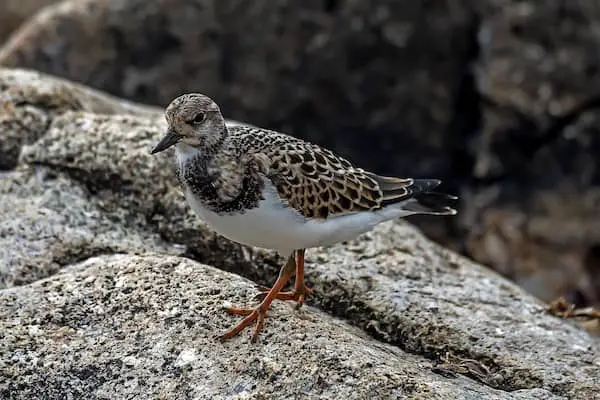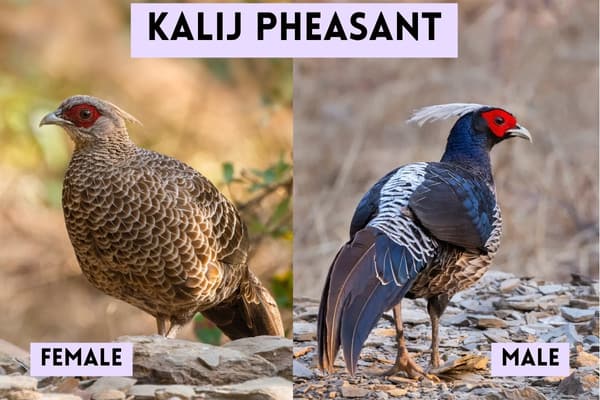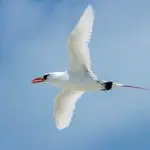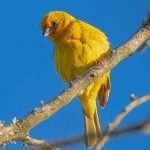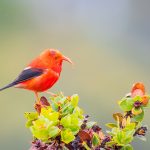A trip to Hawaii is one that will be filled with beautiful wildlife. There’s nothing like seeing a rare honeycreeper peek out from behind a leaf, or birds common in other countries that you’ve never seen. Hawaii’s Big Island is a prime location for birds. This island, also known as Hawai’i island, is the largest of the islands in the Hawaii archipelago. It is home to Mauna Loa, one of the most well-known volcanoes in the island chain. We’ve put together a list of 31 species you may run into while visiting the beach, a state park, driving through the countryside or just hanging out at a resort.
31 Birds on Hawaii’s Big Island
The largest island, Hawai’i Island, is colloquially known as the “Big Island.” Multiple biological zones thrive on the Big Island. A lofty volcanic mountain range in the center of the island divides it in two. On the western side, the volcanoes block wet winds, creating a surprisingly dry grassland and scrub landscape. On the other side, there are thick jungles, tall trees, and higher rainfall.
Let’s dive in to 31 species, both native and introduced, that can be found on the Big Island.
1. Hawaiian Hawk
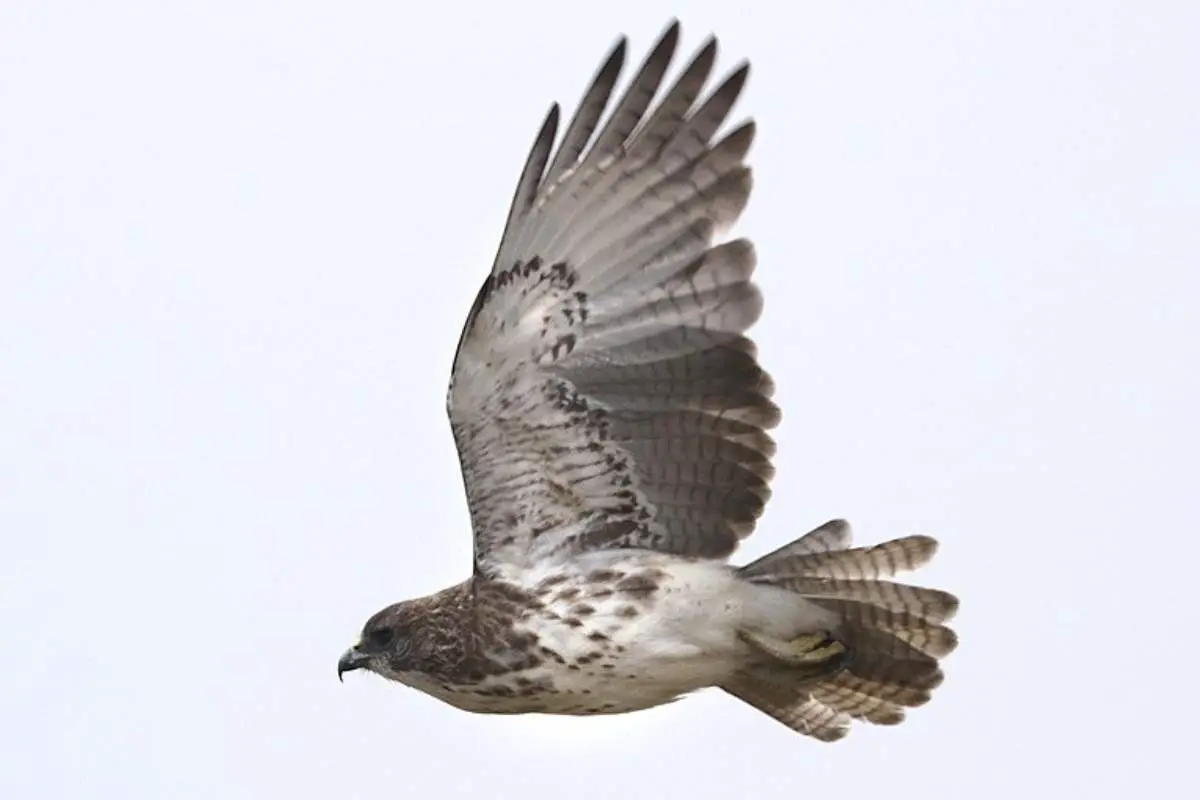
- Scientific name: Buteo solitarius
- Other names: ‘Io
- Native: Yes
Hawaii’s big island is home to a significant population of ‘Io, the Hawaiian hawk. While this hawk has been spotted a few times on other islands, most of its population is on the Big Island, and it is currently the only island they are known to breed on. They have a brown head and either a light breast and underwings (light morph) or dark breast and underwings (dark morph).
Like most island birds, they are smaller proportionally than mainland birds. That doesn’t get in the way of their strength and power, though. They mate for life and are usually monogamous. While they nest and hunt in a variety of habitats around the island, they have a preference for ‘ohi’a forests.
Originally, birds made up most of their diet. However since small mammals like rats, mongoose and mice have been introduced to the island, they will incorporate those as well. Look for them soaring or perching up high while driving around.
2. Short-eared Owl (Hawaiian)
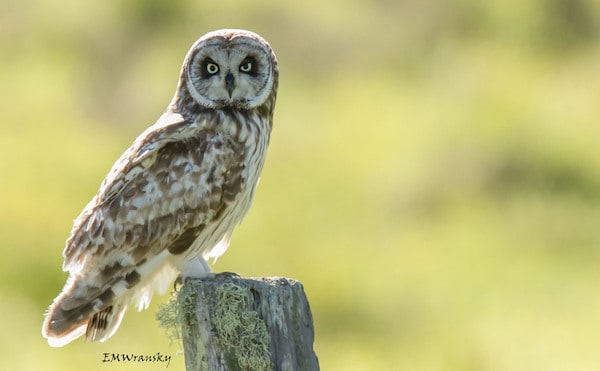
- Scientific name: Asio flammeus sandwichensis
- Other names: Pueo
- Native: Yes
While the short-eared owl can be found in many places around the world, this is a subspecies only found on the Hawaiian Islands. Often referred to as Pueo, these owls actually hunt during the day in open pastureland and forests.
The Hawaiian Short-eared Owl has mottled brown and white plumage, with large, bright yellow eyes and short, feathered ear tufts. Their ear tufts are generally hard to see, so their head just appears round with dark patches around the eyes and a pale face.
You’ll likely see them perched on fenceposts or dead trees, or flying low over open fields. Although they are considered native to the islands, they did not live on the islands before people arrived. These owls eat mainly rodents, and before humans Hawaii’s only land mammals were bats, so they didn’t have a good enough food source. It is believed they only became a permanent resident to the islands after Polynesian rats arrived with Hawaii’s first settlers.
The Pueo is an important part of Hawaiian culture and mythology, and is considered a sacred bird by many Native Hawaiians. They are looked at as ‘aumakua, family guardian spirits. Unfortunately their numbers are declining due to factors including habitat loss, light pollution, and introduced mammals like the Indian mongoose that eat their eggs and young.
Sightings on the Big Island tend to occur around Mauna Kea. Many people spot them from the main roads that pass through that area like Saddle Hill Rd and the Inouye Highway.
3. Yellow-billed Cardinal

- Scientific name: Paroaria capitata
- Other names: –
- Native: No
The pretty yellow-billed cardinal is native to South America. Their coloration is similar to another cardinal you may see in Hawaii, the red-crested cardinal, but you can tell them apart quickly by their yellow-orange beak and round head with no crest. Adults have a dark back, white underside, dark red head and black throat patch. If you see birds that look like this but their head is brown instead of red, those are the juveniles.
Yellow-billed cardinals like waterside habitat, so they are perfectly at home in Hawaii. They often forage on the ground in small groups for seeds and insects. Introduced to Hawaii around the 1960’s, they are commonly seen in grassy fields, shrubby gardens and parking lots.
4. Hawaiian Coot

- Scientific name: Fulica alai
- Other names: ‘alae ke’oke’o
- Native: Yes
This coot species in only found on Hawaii. With their dark body, white beak and white forehead shield, they look very similar to the more widespread American coot. However the frontal shield on the Hawaiian coot is much larger and more rounded. It can appear all white or dark red.
Find these coots in wetlands, ponds, marshes, canals and in grassy areas adjacent to water such as lawns and golf courses. Coots have large, lobed toes that help them swim, but are better for walking on aquatic vegetation and land than fully webbed feet.
The Hawaiian coot was listed as a federally endangered species in 1970. You my get some lucky golf course sightings, or look for them at Aimakapa Fishpond and Lokowaka Pond.
5. Pacific Golden Plover
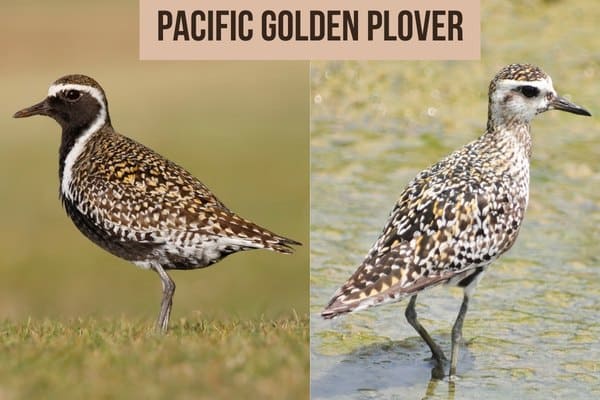
- Scientific name: Pluvalis fulva
- Other names: Kōlea
- Native: Yes, migratory
These plovers come to Hawaii to do what many of us would like to do, spend the winter. The Pacific golden-plover (locally called kolea), typically arrive in Hawaii in late August or early September, flying in from their breeding grounds in the Arctic tundra. During their migration, they fly non-stop for up to 88 hours, covering distances of up to 4,000 km.
For most of the winter their coloring will be a pale belly, with a back heavily mottled in brown, white and hints of gold. Find them on open lawns, golf courses and fields. At night they are known to roost in flocks, sometimes on hotel rooftops. They are also attracted to wetlands and mudflats, where they can find a variety of insects and invertebrates.
As spring approaches, they put on their “tuxedos”. Males sport solid black feathers on their face and belly, while females will also add black to those areas, but in patchwork instead of solid. Come April, they begin their migration back to their breeding grounds in the Arctic.
6. Hawai’i ‘Amakihi

- Scientific name: Chlorodrepanis virens
- Other names: common ʻamakihi,
The Hawaii Amakihi is a small, yellow honeycreeper that is native to Hawaii. Adults look similar, with males being bright yellow and females being more of a greenish-yellow. They have a dark, curved bill and a slight dark shadow in front of their eyes.
Amakihis have a tubular tongues they use to feed on nectar, but they also consume insects, small invertebrates and can suck the juice from fruit. This species has a long breeding season that can last for up to nine months and include two broods of chicks.
Today, they are found on the Big Island, Maui and Molokai. They are able to live in various types of habitat but require forested areas, and can live at elevations up to 8,000 feet. Many of Hawaii’s native forest birds have seen a steep decline from habitat changes and avian disease, however the Amakihis have proven to be the most resilient so far. It is even thought they may be evolving a resistance to avian malaria.
Some good spots to look for them on the Big Island include Pu’u Wa’awa’a Forest Reserve, Hawaii Volcanoes National Park, and most of the forest reserves throughout the island.
7. Zebra Dove
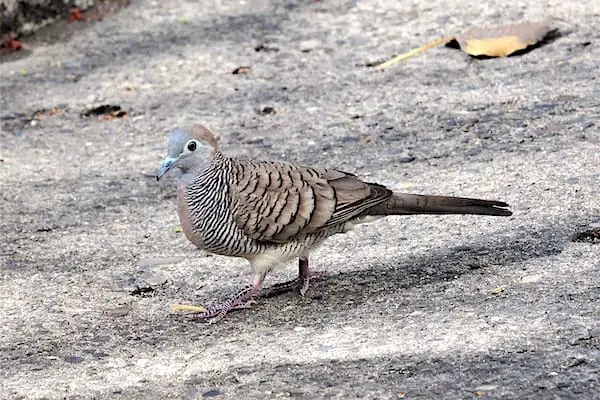
- Scientific name: Geopelia striata
- Other names: Barred Ground Dove
- Native: No
The zebra dove is a small bird that is native to Southeast Asia. Their feathers are a mix of brown, gray, and black, with distinctive black and white stripes on their neck and breast. They have pink legs, and pale blue skin around their eyes. Their call is a series of rapid “coos”, and they are often found in pairs or small groups.
The zebra dove is primarily a seed-eating bird, but they also consume insects and small invertebrates. They are known to forage on the ground, searching for food among grasses and leaves. They are also attracted to bird feeders and will readily consume seeds that are provided for them. In Hawaii, the zebra dove is a common sight in urban and suburban areas, where they feed on grass seeds and insects that are found in gardens and parks.
Zebra doves are monogamous and form long-term pair bonds. They build their nests on the ground, often in grassy areas or under shrubs. The female typically lays two eggs, which are incubated by both parents. Once the chicks hatch, they are fed by both parents until they are able to fend for themselves.
Zebra doves were introduced to Hawaii in the 1920’s and spread quickly across the islands. They are known for being rather tame, and frequenting outdoor eating establishments. Watch out for these guys if you are at an outdoor restaurant, some are so bold they will land on tables and chairs!
8. Saffron Finch

- Scientific name: Sicalis flaveola
- Other names: Pelzeln’s Finch
- Native: no
Saffron finches came to the Hawiian islands around 1965 and have expanded to most of the islands. The largest populations of these birds are found on the Big Island and O’ahu. These pretty birds are most often seen along the coasts on open lawns with short grass like resorts, parks and golf courses.
Saffron finches may look like canaries, but are members of the tanager family from South America. Males are bright yellow all over with hints of orange on his head. Females are dully and streaky with hints of yellow. Seeds and insects make up most of their diet.
9. Common Waxbill
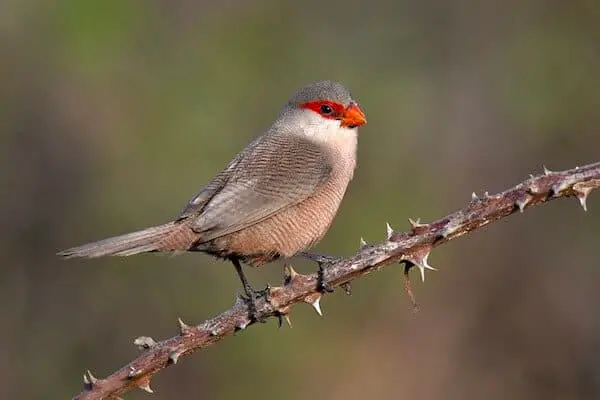
- Scientific name: Estrilda astrild
- Other names: St Helena Waxbill
- Native: No
The cute common waxbill is native to sub-Saharan Africa, and was first reported in Hawaii around the 1970’s. They have been spotted on most of the islands.
The common waxbill is a small bird, measuring about 4 inches in length. They have a distinctive orange-red bill and a red patch over their eyes. Their body is gray-brown and very finely barred.
In Hawaii, the common waxbill feeds on seeds, insects, and small invertebrates. The bird is known for its acrobatic feeding behavior, often hanging upside down from branches to reach its food. Look for them in urban and suburban areas, as well as agricultural areas. You’ll often see them foraging in the grass and tall weeds. These social birds often gather together in large, mixed flocks.
10. Wandering Tattler

- Scientific name: Tringa incana
- Other names: ‘Ūlili
- Native: Yes, Migratory
This medium-sized shorebird is a migratory species that breeds in the Arctic regions of North America and Asia. They spend their winters in the Pacific Islands, including Hawaii, as well as in coastal regions of North and South America. During their migration, they can be found in a variety of habitats, including rocky shorelines, tidal pools, and estuaries.
During the breeding season, the wandering tattler has a mottled brown and white plumage, with a distinct white eyebrow stripe and a dark patch on the back of the neck. However in Hawaii you’ll mostly see their non-breeding plumage, when it changes to a more uniform gray-brown coloration. The white eyebrow stripe is still present, but the dark patch on the back of the neck is less distinct.
Wandering tattlers are primarily insect-eating birds, but they also consume small crustaceans, mollusks, and fish. You’ll see them alone or in small groups, foraging in shallow water, using their long legs to wade and their beaks to probe the mud for food. They are also attracted to rocky shorelines and tide pools, so look for them along the coast from fall to early spring.
11. Common Myna
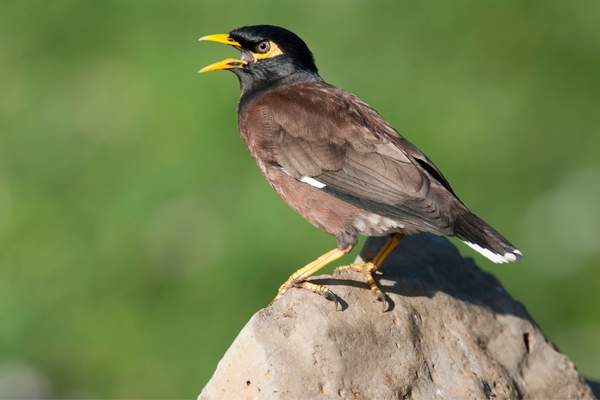
- Scientific name: Acridotheres tristis
- Other names: Indian Myna, Indian Mynah
- Native: No
The Common Myna is a member of the starling family. Both males and females have yellow bills, legs, and skin around the eyes. They have a brown body, black head, and large white wing patches visible when they fly.
They aren’t particularly shy of humans, so they are one of the most often spotted birds on Maui since they hang out around human developed areas like the airport, hotels, beaches and parks. Common mynas are omnivorous birds that eat pretty much anything they can find, including insects, arachnids, crustaceans, reptiles, seeds, grain, and fruits. They will also probably be interested in any food you happen to drop on the ground.
In the evening, large groups of Common Mynas gather in communal roosts in large trees. They are very “chatty” birds and can be quite noisy when they all get together.
In Hawaii, Common Mynas are considered an invasive species and are known to displace native birds and deplete their food supply. They were introduced from India in the 1850’s to help control insect pests like army worms. Unfortunately their territorial behavior has led to some negative impacts on the ecosystem.
12. House Sparrow
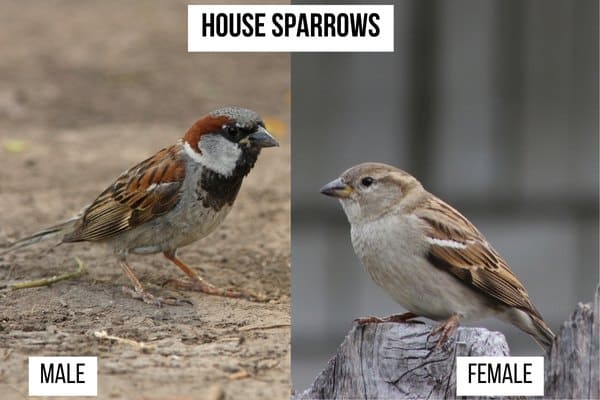
- Scientific name: Passer domesticus
- Other names: none
- Native: No
The house sparrow is a small bird that is native to Europe, Asia, and North Africa. They have since been introduced to many parts of the world, including Hawaii. Both sexes have a mix of brown, gray, and black feathers. The male has a distinctive black bib on its throat, and rufous patch at the nape of the neck, while the female has a plain brown head.
House sparrows are primarily seed-eating birds, but they also consume insects and small invertebrates. They are known to forage on the ground, usually in a group, using their beaks to search for food among the grass and leaves. A common sight in urban and suburban areas, they are very at-home with man-made structures. You may see them nesting in storefront signs or other nooks and crannies of buildings.
They love to search for human food in high-traffic areas like beaches, outdoor restaurants and cafes. Don’t walk away from your plate if eating outside, or you might come back to find a House Sparrow sharing your meal!
House sparrows are social birds and are often found in large flocks. They are also known for their aggressive behavior towards other birds, often competing with native species for food and nesting sites.
13. Apapane

- Scientific name: Himatione sanguinea
- Other names: –
- Native: Yes
The Apapane is the most abundant honeycreeper in Hawaii and is found on most of the main islands, including the Big Island. They may be the most populous native Hawaiian bird. Adults are red with black on their wings and tail, and a white patch below the tail. They have black legs and a black, slightly down-curved beak. Juveniles are brownish yellow.
Apapanes are primarily nectar-eating birds, but they also consume insects and spiders. They forage in the canopy of trees, using their beaks to sip nectar from the flowers of native plants. Often found in flocks feeding on ‘ohi’a trees. They have a long history of association with Hawaiian culture. They have been used in Hawaiian chants and songs, and are considered a symbol of love and loyalty.
The Apapane is also an important species in the ecosystem of Hawaii. They are important pollinators of native plants, and their presence is an indicator of the health of the forest ecosystem. Despite their importance, the Apapane is threatened by habitat loss and the introduction of non-native species.
To find these birds you’ll need to head for forest reserve areas with flowering trees.
14. Spotted Dove

- Scientific name: Spilopelia chinensis
- Other names: Indian Turtle Dove
- Native: no
The Spotted Dove is a small bird that is native to Asia and brought to Hawaii in the 1800s. They have an overall soft, rosy coloring with brown wings and a distinctive black patch on their upper back covered in white dots.
Spotted doves are primarily seed-eating birds, but they also consume insects and small invertebrates. They forage on the ground in open fields, parks, forests and gardens. They are fairly tame and comfortable in urban and suburban settings, so you’re likely to run into one on any of the islands.
Spotted doves are monogamous and form long-term pair bonds. In Hawaii they breed year-round, building their nests in trees or shrubs, using grass, twigs, and other materials to create a sturdy structure. As part of courtship, males will bow, coo, and make aerial displays.
15. Yellow-fronted Canary
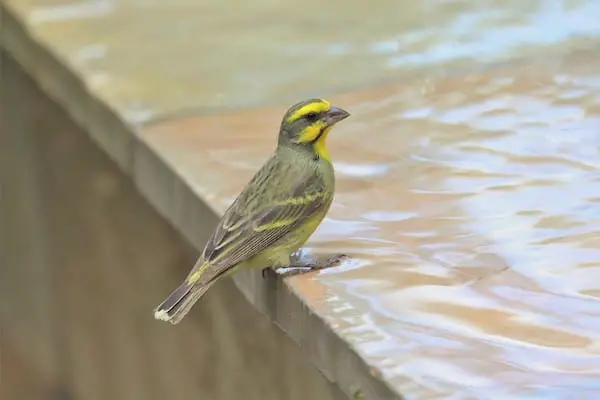
- Scientific name: Crithagra mozambica
- Other names: Yellow-eyed Canary, Green Singing Finch
- Native: No
The yellow-fronted canary is a small, Africa-native bird that belongs to the Finch family. These birds are popular among pet owners for their beautiful plumage and their delightful singing. According to Hawaii.gov, they were brought to the islands in the 1960’s and have established wild populations on O’ahu and the Big Island.
Yellow-fronted canaries have an olive colored body and head, with a yellow breast and yellow wingbars. Their most striking feature is their face, with a bright yellow stripe above and below their eye. Males and females look alike, but males have a slightly brighter yellow forehead. These birds have a small, conical beak that is adapted for cracking seeds, their primary food source.
In the wild, yellow-fronted canaries feed on a variety of seeds, including grasses, weeds, and flowers. They also eat insects and other small invertebrates, especially during the breeding season when they need extra protein to raise their chicks. In Hawaii, these birds are considered an agricultural pest because they feed on crops such as corn, sorghum, and rice. Despite their reputation as pests, yellow-fronted canaries are beloved by many people for their cheerful songs and vibrant colors.
16. Hawaiian Goose
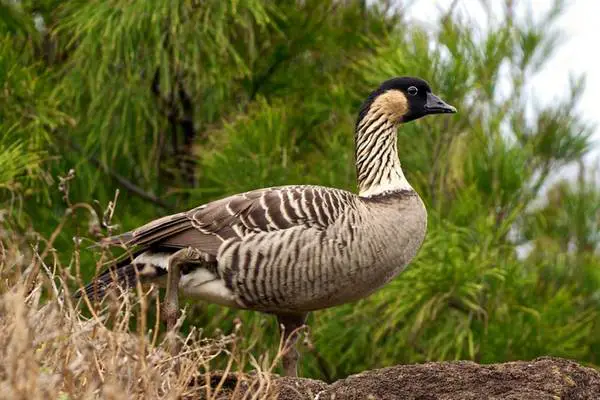
- Scientific name: Branta sandvicensis
- Other names: Nene
- Native: Yes
The Hawaiian Goose, also known as the Nene, is a medium-sized goose species that is endemic to Hawaii. Nene’s have a black face, buffy cheek patch, barred brown and cream body. Their neck feathers have a unique look, cream colored with deep grooves and ridges that give it the appearance of brown streaks.
They spend most of their time on the ground, but they are able to fly. Having the longest breeding season of any goose, 7 months, females build the nests and lay 1-5 eggs at a time. Nene graze on various types of plant materials, including leaves, grasses, shrubs, flowers, fruit and seeds.
It is believed that this species evolved from the Canada Goose, which likely wound up in Hawaii 500,000 years ago. Today, the Hawaiian Goose is an endangered species, with only around 2,000 individuals remaining in the wild. They are threatened by habitat loss and degradation, as well as by introduced species such as rats and mongooses that prey on their eggs and young.
Interestingly, these geese were breed in captivity in England starting in the 1950’s and reintroduced to various protected areas in Hawaii as part of a conservation effort. This likely saved the Nene from extinction. Listen for their honking call, and you may see them at parks and golf courses around ponds, at beaches, or Volcanoes National Park.
17. Java Sparrow
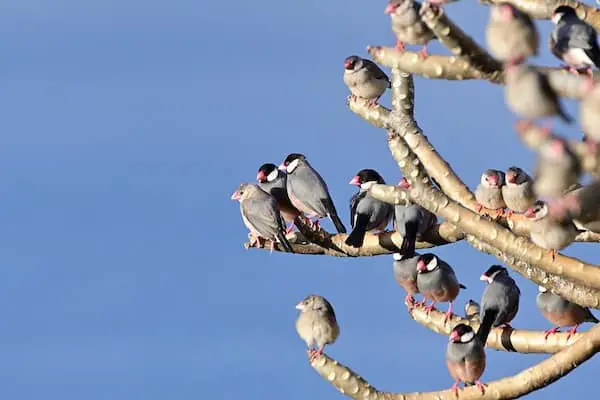
- Scientific name: Padda oryzivora
- Other names: Java Finch
- Native: No
The java sparrow is a small bird that is native to Indonesia. They have since been introduced to many parts of the world, including Hawaii where they were they have spread from O’ahu in the 1960’s to most of the main islands. These social birds are often found in pairs or small flocks.
These large finches are easy to identify due to their unique coloration. They have gray bodies with rosy bellies, a black head, bright white cheek patches, a red eye and thick pink beak.
Java sparrows are primarily seed-eating birds, and can be considered pests in rice fields and other agriculture due to their appetite. In fact, they used to be a common exotic pet bird in the continental United States until their importation was banned due to escaped birds potential threat to agriculture.
In Hawaii, the java sparrow is a common sight in urban areas and gardens. They are more often seen along coastal areas than far inland.
18. Hawaiian Thrush (ʻŌmaʻo)
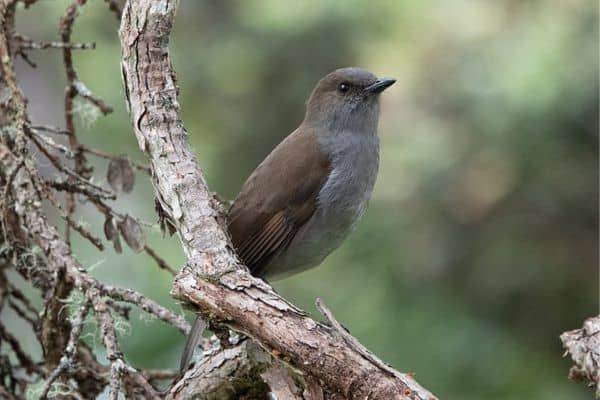
- Scientific name: Myadestes obscurus
- Other names: ʻŌmaʻo
- Native: Yes
The ‘ōma‘o is the most populous species of Hawaiian thrush. Its charcoal gray and brown plumage certainly provides more camouflage compared to the brightly-colored honeycreepers that share the forest. They perch quietly in the canopy, sometimes fluttering their wings.
This Hawaiian thrush eats mainly fruit and berries, and supplements that with insects, spiders and snails. They were once common throughout the island, but for nearly 100 years have retreated to the slopes of the Mauna Kea and Mauna Loa volcanoes. They are mainly found in rainforests above 3,000 ft that have ohia and koa trees.
19. Ruddy Turnstone
- Scientific name: Arenaria interpres
- Other names: ‘akekeke
- Native: Yes, Migratory
Ruddy turnstones are common shorebirds that breed in the Arctic regions of North America and Eurasia. They migrate to spend their winters in coastal regions of North and South America, as well as in the Caribbean and other tropical regions like Hawaii. These common winter visitors to the islands are called ‘akekeke.
When you see them in Hawaii, they will be in their non-breeding plumage. They have a pure white belly, orange legs, a brown and black mottled head and back, and a faint black band along the chest. They have short, pointed beaks that are ideal for foraging for small invertebrates and crustaceans, which make up the majority of their diet.
Find them in groups along beaches and rocky shoreline. While you probably won’t be able to notice from afar, their feet are a bit spiny with sharp nails that help them grip slippery wet rocks. Look for them especially in areas where seaweed, shells and other debris washes up and deposits along the shore.
20. Scaly-breasted Munia
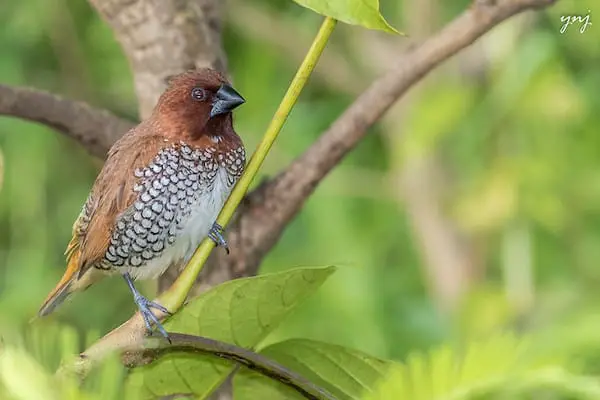
- Scientific name: Lonchura punctulata
- Other names: Nutmeg Mannikin, Spice Finch, Ricebirds
- Native: No
This species is native to India and southeast Asia. Once introduced to Hawaii in the late 1800’s, they spread pretty rapidly to most of the islands. The scaly-breasted munia has a warm brown back and head, thick black beak, and white underparts with a distinctive scaly pattern.
They feed on a variety of grass seeds, including rice, millet, and other cultivated grains. Because of this they are often found in agricultural areas. They are also attracted to bird feeders and will readily consume seeds that are provided for them, such as millet, sunflower seeds, and other small seeds.
In addition to seeds, scaly-breasted munias also feed on small insects and invertebrates, particularly during the breeding season when they need extra protein to raise their young. They are known to feed on ants, beetles, and other small insects that they find on the ground or in low vegetation.
21. Kalij Pheasant
- Scientific name: Lophura leucomelanos
- Other names: kaleege
- Native: No
The Kalij Pheasant is a beautiful ground bird species that is native to the forests of the Himalayas in India, Pakistan, Nepal, and Bhutan. These birds have also been introduced to other parts of the world, including Hawaii where they are mostly found on the Big Island. The males of the species have a glossy blue-black plumage with a distinctive white crest on their heads and bright red patch around their eyes. The females, on the other hand, are mostly mottled brown with a short brown crest.
Kalij Pheasants were brought to Hawaii in the early 1960’s as a game bird for hunting. They are most common in upland (mountain, hill & slope) areas. Keep an eye out for them scurrying along the ground while driving through elevated areas.
22. Red Junglefowl

- Scientific name: Gallus gallus
- Other names: Moa
- Native: No
The Red Junglefowl, also known as Moa, is a forest-dwelling chicken introduced to Hawaii by Polynesian settlers who arrived on the islands around 1,500 years ago. The settlers brought with them a variety of plants and animals, including chickens, which were used for food and as a source of feathers for clothing and adornments.
The male Red Junglefowl, also known as the rooster, is larger and more colorful than the female. They have a bright red comb on top of their head, as well as a long, curved tail feathers that are used in courtship displays. The male’s plumage is also more colorful, with a mix of red, orange, gold and metallic green. The female Red Junglefowl, also known as the hen, is smaller and less colorful than the male. They have a brown body and slightly lighter tan neck which helps to camouflage them in their natural habitat.
Over time, the Red Junglefowl became established in Hawaii and began to thrive in the islands’ warm and humid climate. Today, the Red Junglefowl is a common sight in Hawaii, particularly along roadsides and in rural areas. Some are still kept by locals, while others are wild.
23. Warbling White-Eye

- Scientific name: Zosterops japonicus
- Other names: Japanese White-eye, Mejiro
- Native: No
The Warbling White-eye, also known as the Japanese White-eye or Mejiro, is a small songbird that is native to Japan, Taiwan, and the Philippines. Their feathers are a mix of green, yellow, and white, with a distinctive white ring around their eyes. The Warbling White-eye has a small, pointed beak that is ideal for probing flowers and fruit. They have a melodious song that is often heard in the forests and gardens of Hawaii.
Warbling White-eyes are primarily a nectar and fruit-eating bird, but they also consume insects and small invertebrates. They are also attracted to bird feeders and will readily consume sugar water that is provided for them.
Warbling White-eyes were introduced to O’ahu in 1929 and quickly spread to all the islands. They have been so successful, that they have been considered Hawaii’s most abundant land bird since the late 1980’s. Unfortunately they have been identified as a vector for avian parasites that adversely affect native Hawaiian birds like honeycreepers.
Look for them among leaves and flowers in gardens, parks and forests.
24. Black-crowned Night-Heron
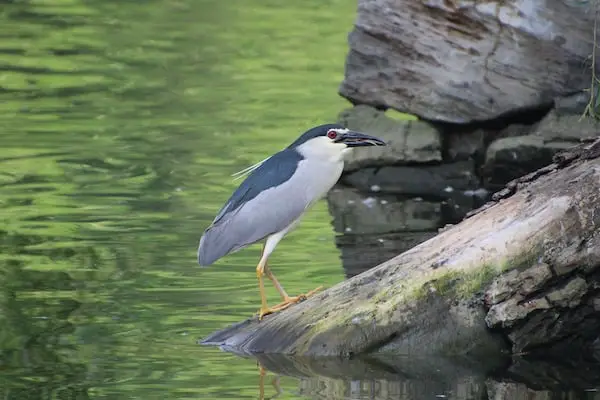
- Scientific name: Nycticorax nycticorax
- Other names: ‘Auku’u
- Native: yes
The Black-crowned night-heron is a medium-sized wading bird that is native to several continents, and is considered a native species in Hawaii. Locally they are called ‘auku’u. Unlike many herons with long legs and necks, the black-crowned night-heron has a squat shape with shorter legs. They have a gray body, with a black crown and back, and red eyes. During the breeding season, a few long white feathers stream from the back of their head. Juveniles are brown and spotted.
They hunt for fish, shellfish, frogs, lizards, mice, insects and even smaller birds. Find them near ponds, marshes, streams and shoreline, remaining still while watching for prey then striking out with their sharp beak.
Black-crowned night-herons are a solitary bird and are often seen alone or in small groups. They build their nests in trees or shrubs.
25. House Finch

- Scientific name: Haemorhous mexicanus
- Other names: Papaya birds
- Native: No
The house finch is a small songbird that is native to North America. Both males and females are heavily streaked with brown and cream, but males also sport a red wash on the head and chest. Interestingly, males can sometimes show orange and yellow coloring instead of red, and this is more commonly seen in Hawaii than on the mainland.
The red coloring in their feathers come from carotenoid pigments in the foods they eat while they are going through the molting process. In Hawaii, house finches really enjoy eating the tropical fruit papaya. So much so, that some locals call them “papaya birds”. Papaya doesn’t have enough carotenoids to produce dark red feathers, so House Finches that consume a lot of papaya tend to be more orange or yellow.
They were introduced to Hawaii in the mid 1800’s and are now common on all the main islands. House Finches mainly eat seeds, grains and berries. They are known to forage on or in vegetation, and readily visit bird feeders. They like mixed seeds, sunflower or like many finches, thistle seed. House Finches are a social bird and are often found in flocks, especially during the winter months.
26. Hawaii ‘elepaio

- Scientific name: Chasiempsis sandwichensis
- Other names: –
- Native: Yes
The Hawai’i ‘elepaio is one of the few native Hawaiian birds on the Big Island that isn’t endangered. Smaller birds at about 5 inches long, they have a warm brown body, dark tail and white rump. Their name comes from the song of the male, which is described as a shrill “El-eh-pie-oh”.
There are actually three subspecies found on the Big Island. The “Kona ‘elepaio” lives in mesic forest with koa and ohi’a lehua trees. The “volcano ‘elepaio” is the most common, living in the rainforest with ohi’a lehua and hapu’u trees. Lastly, the “Mauna Kea ‘elepaio” is the rarest, only found in mamane forest on the leeward slopes of Mauna Kea.
As a member of the flycatcher family, they are insect eaters. They can pluck insects out of the air or snatch them off of foliage. Mated pairs remain together all year, and many stay together for the long-term. Find them mainly in forested areas above 2,000 ft.
27. ‘I’iwi

- Scientific name: Drepanis coccinea
- Other names: Scarlet honeycreeper
- Native: Yes
The ‘I’iwi is perhaps the most iconic Hawaiian bird. Also called the Scarlet Honeycreeper, the ‘I’iwi is the third most common native land bird on the islands. Their deep red body and black wings make them an easier bird to spot among green foliage. Their most unique feature may be their large, pale pink, curved (almost hook-shaped) beak.
This beak shape, like other honeycreepers, is designed to aid them in reaching nectar inside tubular flowers. This may sound like a little bit like a hummingbird, and you aren’t far off. In fact, their are no hummingbirds in Hawaii, and the honeycreepers have filled in the role of nectar-drinking and pollinating birds. ‘I’iwis are in the genus Drepanis, which used to contain three species of honeycreeper with deeply curved, sickle-like bills. However the ‘I’iwi is the last one remaining, with the Hawai’i mamo and the Black mamo both now extinct.
The ‘I’iwi is an important cultural symbol in Hawaii. It is considered to be a sacred bird in Hawaiian mythology, and its feathers were used in traditional Hawaiian clothing and adornments. Most ‘I’iwis today can be found in small pockets on Maui and the Big Island. The Kaulana Manu Nature Trail, Hakalau Forest National Wildlife Reserve, and the Devastation Trail are all some accessible places to look for them.
28. Northern Cardinal

- Scientific name: Cardinalis cardinalis
- Other names: –
- Native: no
Native to North America, many American visitors may be surprised to see this cardinal in Hawaii. They were introduced to Hawaii in the early 1930s as part of an effort to introduce new bird species to the islands as a way to add more diversity to the bird population. Although that may not have been the best idea for the native bird species, these cardinals are generally well loved for their color and cheerful song.
Males are bright red with a black face mask, while the females have a more subdued brownish-red coloration. Both sexes have a distinctive crest on their head and a short, conical orange beak. Northern Cardinals are primarily seed-eating birds, but they also consume insects and small invertebrates.
They are attracted to bird feeders and will readily consume seeds that are provided for them. They have several variations of a melodious, whistling song. Males sing loudly from high perches, and are among the first birds you will hear in the morning. Northern Cardinals can be found throughout much of the Big Island, and are often seen at resorts.
29. Red-billed Leiothrix
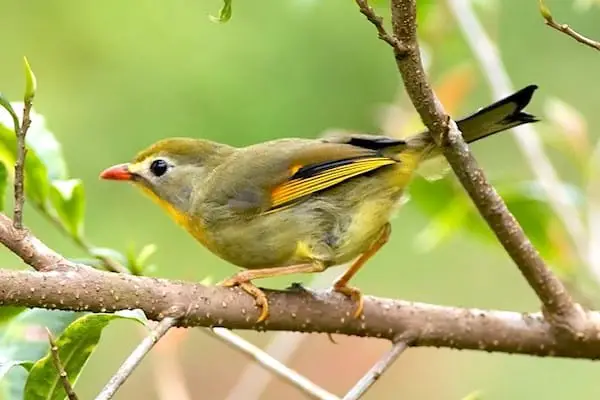
- Scientific name: Leiothrix lutea
- Other names: Pekin robin, Pekin nightingale, Japanese nightingale, Japanese hill robin
- Native: no
The Red-billed Leiothrix is a small, colorful bird native to the Himalayas and parts of Southeast Asia. Many nicknames have been assigned to this little songster, including Chinese hill robin, Pekin robin and Japanese nightingale. They have an olive-yellow body with a yellow-orange chest, yellow streaking on the wings, an orange beak, white dusting around the eye and a dark tail tip.
Red-billed Leiothrixes are primarily insectivorous, feeding on a variety of small insects and invertebrates that they find on the ground or in the trees. They are known for their melodious and complex songs, which are used to establish territory and attract mates. Known to be secretive, they like to remain hidden in foliage but are always moving around and singing. You may also hear them giving a scolding call when people get too close.
They were introduced to Hawaii in 1918 and spread to most forested areas. Leiothrix eat insects and fruits, helping to disperse seeds throughout their habitat. They are most common in forested areas along the western coast and around the volcanoes.
30. Cattle Egret
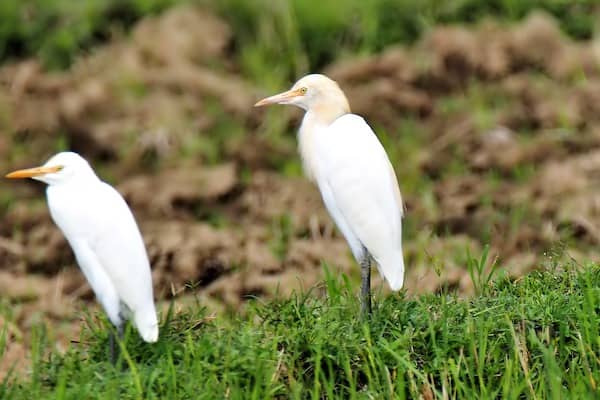
- Scientific name: Bubulcus ibis
- Other names: n/a
- Native: No
The Cattle Egret is a medium-sized bird that is native to Africa and Asia, but can be found in many parts of the world today. Their feathers are mostly white, although you may see a buffy orange-brown patch on their head, breast, back and neck during breeding season. The cattle egret has a long, pointed beak that is yellow in adults and darker in juveniles. Their legs are yellow when breeding, and black when not.
Cattle egrets are primarily insect-eating birds. They are known to forage in fields and pastures, often following livestock such as cows and horses to catch insects that are disturbed by their movement. In fact, sometimes they will perch right on their back! In Hawaii, the cattle egret is a common sight in agricultural areas and grasslands. Unlike most egrets, they prefer to get their food in dry areas, but you’ll still see them near beaches and ponds throughout the Big Island.
Cattle egrets have been introduced to many regions to control insect populations in agricultural areas, and have even been used to control pests on golf courses. They were brought to Hawaii in the 1950’s and 60’s to help control cattle pests, and have thrived.
31. Black-necked Stilt

- Scientific name: Himantopus mexicanus knudensi
- Other names: Hawaiian Stilt, Ae’o
- Native: Yes
Black-necked Stilts are medium-sized wading birds native to North and South America. The Black-necked Stilt has quite a distinctive look, with its black and white plumage, long pink legs and long thin bill. The ones that live in Hawaii are often considered their own subspecies, the Hawaiian Black-necked Silt or Ae’o.
They use their long, stilt-like legs to wade in shallow water while probing the mud with their beak for food. Insects, crabs, worms, and fish are all on the menu, so you’ll find them foraging in shallow water bodies. In proportion to their body size, they have the second-longest legs of any bird species.
Most of the Hawaiian stilts live on Maui, Oahu and Kauai. While the North and South American populations are fine, the Hawaiian stilt is considered endangered. Loss of wetland habitat and introduced mammal predators like cats, dogs and mongoose are some of the main causes.
Look for them along the west coast at parks and resorts between Keokea and Kukio.

